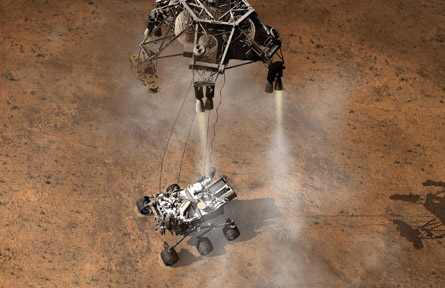As NASA's Mars Science Laboratory spacecraft crossed the halfway mark en route to its 6 August landing and deployment aboard the Curiosity rover that will carry it around the Martian surface to collect and test soil samples, the US space agency this month has kicked off a new round of planning for future missions to our nearest neighbour.
The next good opportunities to reach Mars will come in 2018 and 2020, when it will relatively near to Earth, so NASA is gearing up to plan a mission that can put to good use some $700 million to $800 million nominally budgeted for Mars in that timeframe. The Mars Program Planning Group (MPPG) is semi-independent of NASA, and is charged with taking in ideas from scientists worldwide to help it advise the agency on how best to advance its scientific and human exploration objectives. A mission in the late 20-teens or early 2020s could be part of a broader challenge, raised by President Barack Obama, of sending humans to Mars in the 2030s.
 |
|---|
| © NASA Curisoty expects a soft landing with help from a rocket-powered crane |
John Grunsfeld - a five-time Shuttle astronaut who now heads NASA's science mission directorate - is careful not to give any indication of the sort of mission he thinks should be mounted later this decade. Outlining the group's remit in Washington DC earlier this month, he batted away detailed questions about a 2018 mission, declining even to say whether the mission should involve an orbiter or a lander. Grunsfeld insists he does not want to prejudice the MPPG's findings, which will be presented to NASA in August around the time of the Mars Science Laboratory planned landing.
There are two reasons why NASA may be looking to draw on a collegial approach to planning what amounts to 20-year roadmap for Mars. As Grunsfeld notes: "Mars looks like a different planet to us today than it did in 2000 when we last did our major replanning effort." Then, he says, Mars seemed lifeless and dry, but recent discoveries by NASA and European Space Agency missions show methane in the atmosphere, evidence of warm seas at some point in the planet's past, and a current hydrological cycle.
In short, the more we know about Mars the more we know what to look for and how to look for it; to lay down a firm plan would be premature, and even the MPPG's August remit looks rapid on this measure. As Grunsfeld says, the MSL/Curiosity mission should raise specific questions that a next mission could investigate. One of the MSL's key tasks will be to study the organic and inorganic chemistry of the Martian soil, and it would clearly be foolish now to make any hard plans about what sort of science a further mission should undertake.
But the other reason for NASA's interest in casting beyond its own walls for ideas is highlighted by the fact that Grunsfeld refers to this 2018 - or 2020 - mission as a "return" to Mars. NASA will in 2013 launch an orbiter mission to investigate the upper Martian atmosphere, but after that the agency is at the mercy of its budget. The next good opportunity to launch for Mars is not, actually, 2018 - it is 2016, and Congress has all but excluded NASA from participation in ESA's planned ExoMars lander mission scheduled to launch that year.
As Grunsfeld puts it, these are tough times for public spending, and international partners are increasingly what makes space exploration happen. He points to the International Space Station as a "tremendous example" of how "space is an area of collaboration"; when one agency hits a budget impasse, a partner can pick up the slack.
"We're having a tough time in the near term with Mars," says Grunsfeld, "but we're working through that and our international partners understand that."
In any case, as NASA chief scientist Waleed Abdalati puts it: "The exploration of other worlds than our own is inherently a shared endeavour."
Meanwhile, although it is far from clear whether NASA will have a serious Mars budget beyond 2018-2020 and not even certain that budget will survive Washington politics, NASA is at least clear about its long-term objectives; the goal is a sample return mission.
Whether that mission involves humans or robots is another point on which Grunsfeld declines to be drawn. President George W Bush famously declared a manned Mars mission to be a US goal, but that plan was axed by successor Obama, who has brought the notion back as a mere challenge.
Grunsfeld prefers not to clearly define human exploration of the solar system as involving astronauts in pressure suits. "It's all about human exploration," he says; scientists - humans - use tools - robots - to explore, so "it's a spectrum and about where the humans are located".
A much more urgent concern for Grunsfeld and his NASA colleagues is the upcoming August encounter between MSL and Mars, which has been a voracious consumer of spacecraft. ESA's Mars Express orbiter, for example, has been sending back hugely valuable data about the surface for some eight years but its paired lander, Beagle 2, did not arrive safely.
Grunsfeld recalls the Space Shuttle's 40-minute re-entry, descent and landing as a relatively leisurely - and pilot-controlled - experience. By contrast, MSL/Curiosity's trip to the surface from Martian orbit will take just five to six minutes and a radical rocket-powered crane.
"Mars is a really tough place to go," he says. "We still struggle with this on every single mission."
Source: Flight International



















